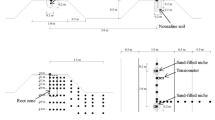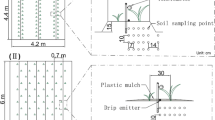Abstract
Purpose
It has always been challenged to improve heavy coastal silt saline soil for crop productions through establishing an irrigation system with saline water. This study was aimed to investigate the effect of the electricity conductivity of irrigation water (ECw) on soil salinity (ECe), sodium adsorption ratio (SAR) and pH of the saturated paste (pHs), tomato yield, and irrigation water use efficiency (IWUE).
Methods
A two-year field experiment of five ECw treatments (0.7, 3.2, 4.7, 6.2, and 7.8 dS m−1, respectively) was conducted under ridge tillage in the Bohai Rim region, China through a drip irrigation system.
Results
A linear correlation between ECw and soil desalinization rate (SDR) and between the irrigated water amount and SDR was revealed and the final average ECe, SAR and pHs readings at 1 m deep soil (40.2 dS m−1, 56.2 (mmol L−1)0.5, and 7.82, respectively) dropped to those within the main root zone with each of five treatments (21.3–26.6 dS m−1, to 32.4–37.1 (mmol L−1)0.5 and 7.16–7.75, respectively), indicating an outstanding soil reclamation. The tomato survival rate was over 90% when the ECw was kept below 7.8 dS m−1, while growth and yield of tomato and IWUE were generally unaffected as the ECw was below 4.7 dS m−1.
Conclusion
The ECw of drip** water should be maintained below 3.9 dS m−1 and the soil matrix potential be controlled above -5 kPa at 20 cm deep soil beneath drip** emitters for a high-yield tomato cultivation in the heavy coastal silt saline lands.










Similar content being viewed by others
References
Abdel Gawad G, Arslan A, Gaihbe A, Kadouri F (2005) The effects of saline irrigation water management and salt tolerant tomato varieties on sustainable production of tomato in Syria (1999–2002). Agric Water Manage 78:39–53. https://doi.org/10.1016/j.agwat.2005.04.024
AOAC (1990) Official Methods of Analysis, 15th edn. Association of Official Analytical Chemists, Washington, DC
Beltrán JM (1999) Irrigation with saline water: benefits and environmental impact. Agric Water Manag 40(2–3):183–194
Cao C, Li K, Ma J, Zheng C (2007) Utilization status and development potential of shallow saline groundwater in Hebei Low Plain. Anhui Agri Sci Bull 13(18):66–68. https://doi.org/10.3969/j.issn.1007-7731.2007.18.034
Chen W, Chen B, Shen Q (2000) Studies of the changes of pH value and alkalization of heavily saline soil in seabeach during its desalting process. Acta Pedol Sin 37(4):521–528. https://doi.org/10.3321/j.issn:0564-3929.2000.04.012
Chen W, Wang W, Liu Z, Zhang L, Yin C, Ni J (2020) Parameters design and its application of subsurface pipe drainage engineering in Yellow River delta. Yellow River 42(1):145–149. https://doi.org/10.3969/j.issn.1000-1379.2020.01.030
Chhabra R (2004) Classification of salt-affected soils. Arid Land Res Manag 19:61–79. https://doi.org/10.1080/15324980590887344
Ding X, Zhou Z, Xu X, Wang Y, Jiang Y, Lu J, Chang Q (2016) Dynamics of soil water and salt in soil under artificial plantation shelterbelt drip-irrigated with saline water in the center of the Taklimakan Desert. Acta Pedol Sin 53(1):103–116. https://doi.org/10.11766/trxb201505130096
Dong S, Wang G, Kang Y, Ma Q, Wan S (2022) Soil water and salinity dynamics under the improved drip-irrigation scheduling for ecological restoration in the saline area of Yellow River basin. Agric Water Manag 264:107255. https://doi.org/10.1016/j.agwat.2021.107255
Feng D, Wan S, Kang Y, Zhang T, Xue Z (2017a) Drip irrigation scheduling for annual crops in an impermeable saline-sodic soil with an improved method. J Soil Water Conserv 72(4):351–360. https://doi.org/10.2489/jswc.72.4.351
Feng G, Zhang Z, Wan C, Lu P, Bakour A (2017b) Effects of saline water irrigation on soil salinity and yield of summer maize (Zea mays L.) in subsurface drainage system. Agric Water Manage 193:205–213. https://doi.org/10.1016/j.agwat.2017.07.026
Guo K, Liu X (2020) Salt leaching process in coastal saline soil by infiltration of melting saline ice under field conditions. J Soil Water Conserv 75(4):549–562. https://doi.org/10.2489/jswc.2020.00161
He J, Den Q, Ma X, Su X, Ma X (2021) Soil salinization affected by hydrogeochemical processes of shallow groundwater in Cangzhou City, a coastal region in North China. Hydrol Res 52(5):1116–1131. https://doi.org/10.2166/nh.2021.183
Heng T, Liao R, Wang Z, Wu W, Li W, Zhang J (2018) Effects of combined drip irrigation and sub-surface pipe drainage on water and salt transport of saline-alkali soil in **njiang. China J Arid Land 10(6):932–945. https://doi.org/10.1007/s40333-018-0061-7
** Z, Lei J, Li S, Xu X (2017) Biochemical intensity and microbial eco-characterization of soils irrigated with saline water from the Tarim Desert Highway shelter-belt. Acta Ecol Sin 37(12):4091–4099. https://doi.org/10.5846/stxb201606131142
Khamidov M, Khamraev K, Azizov S, Akhmedjanova G (2020) Water saving technology for leaching salinity of irrigated lands: A case study from Bukhara region of Uzbekistan. J Critic Rev 7(1): 499–509. https://doi.org/10.31838/jcr.07.01.99
Li D, Wan S, Li X, Kang Y, Han X (2022) Effect of water-salt regulation drip irrigation with saline water on tomato quality in an arid region. Agric Water Manag 261:107347. https://doi.org/10.1016/j.agwat.2021.107347
Li D, Wan S, Kang Y, Li X (2020) Effects of water-salt regulation on tomato growth and quality under drip irrigation with brackish water in coastal saline-alkali soil. J Irrig Drain 39(7):39–50. https://doi.org/10.13522/j.cnki.ggps.2019408
Li Q, Kong F, ** M, Li Y (2018a) Leaching of soil salt with different leaching water volumes in aquaculture ponds of Jiaozhou Bay. Chin J Ecol 37(4): 1127–1134. https://doi.org/10.13292/j.1000-4890.201804.030
Li X (2018) Salt leaching and Iris germanica L. growth in two coastal saline soils under drip irrigation with saline water. Sci Hortic 237:164–168. https://doi.org/10.1016/j.scienta.2018.04.002
Li X (2019) Vegetation establishment in coastal salt-affected wasteland using drip-irrigation with saline water. Land Degrad Dev 30(12):1423–1436. https://doi.org/10.1002/ldr.3324
Li X, Kang Y, Wan S, Chen X, Xu J (2015) Effect of drip-irrigation with saline water on Chinese rose (Rosa chinensis) during reclamation of very heavy coastal saline soil in a field trial. Sci Hortic 186:163–171. https://doi.org/10.1016/j.scienta.2015.02.024
Maas EV (1986) Salt tolerance of plants. Appl Agric Res 1:12–26
Ministry of Water Resources of the People’s Republic of China (MWR) (2010) National Water Resources Comprehensive Planning (2010–2030 Yr). MWR, Bei**g
Moustafa MM (2010) A geostatistical approach to optimize the determination of saturated hydraulic conductivity for large-scale subsurface drainage design in Egypt. Geostatistical 42:291–312. https://doi.org/10.1016/S0378-3774(99)00042-6
Ning S, Zhou B, Shi J, Wang Q (2021) Soil water/salt balance and water productivity of typical irrigation schedules for cotton under film mulched drip irrigation in northern **njiang. Agric Water Manag 245:106651. https://doi.org/10.1016/j.agwat.2020.106651
Ning S, Zhou B, Wang Q, Tao W (2020) Evaluation of irrigation water salinity and leaching fraction on the water productivity for crops. Int J Agric Biol Eng 13(1): 170–177. https://doi.org/10.25165/j.ijabe.20201301.5047
Qadir M, Oster JD (2004) Crop and irrigation management strategies for saline-sodic soils and waters aimed at environmentally sustainable agriculture. Sci Total Environ 323(1–3):1–19. https://doi.org/10.1016/j.scitotenv.2003.10.012
Rhoades JD, Chanduvi F, Lesch S (1999) Soil salinity assessment: Methods and interpretation of electrical conductivity measuremenst. Food and Agriculture Organization of the United Nations, Rome, pp 1–150
Shankar V, Evelin H (2019) Strategies for reclamation of saline soils. In: Giri B, Varma A (eds) Microorganisms in saline environments: strategies and functions. Soil Biology, vol 56. Springer, Cham. https://doi.org/10.1007/978-3-030-18975-4_19
Soria T, Cuartero J (1997) Tomato fruit yield and water consumption with salty water irrigation. Acta Hort. 458: 215–219. https://doi.org/10.17660/ActaHortic.1998.458.25
Spiro RG (1996) Analysis of sugars found in glycoproteins. In: Neufeld ES, Ginsburg V (eds) Methods in Enzymology vol. VIII. Complex Carbohydrates Academic Press, New York, pp 3–26
Sun J, Kang Y, Wan S (2013) Effects of an imbedded gravel-sand layer on reclamation of coastal saline soils under drip irrigation and on plant growth. Agric Water Manag 123:12–19. https://doi.org/10.1016/j.agwat.2013.03.004
Sun J, Kang Y, Wan S, Hu W, Jiang S, Zhang T (2012) Soil salinity management with drip irrigation and its effects on soil hydraulic properties in north China coastal saline soils. Agric Water Manag 115:10–19. https://doi.org/10.1016/j.agwat.2012.08.006
Wan S, Jiao Y, Kang Y, Hu W, Jiang S, Tan J, Liu W (2012) Drip irrigation of waxy corn (Zea mays L. var. ceratina Kulesh) for production in highly saline conditions. Agric Water Manage 104:210–220. https://doi.org/10.1016/j.agwat.2011.12.020
Wan S, Kang Y, Wang D, Liu S, Feng L (2007) Effect of drip irrigation with saline water on tomato (Lycopersicon esculentum Mill) yield and water use in semi-humid area. Agric Water Manage 90:63–74. https://doi.org/10.1016/j.agwat.2007.02.011
Wang R, Kang Y, Wan S, Hu W, Liu S, Jiang S, Liu S (2012) Influence of different amounts of irrigation water on salt leaching and cotton growth under drip irrigation in an arid and saline area. Agric Water Manage 110:109–117. https://doi.org/10.1016/j.agwat.2012.04.005
**e H, Li J, Zhang Y, Xu X, Wang L, Ouyang Z (2021) Evaluation of coastal farming under salinization and optimized fertilization strategies in China. Sci Total Environ 797:149038. https://doi.org/10.1016/j.scitotenv.2021.149038
Wang X, Xue Z, Lu X, Liu Y, Liu G, Wu Z (2019) Salt leaching of heavy coastal saline silty soil by controlling the soil matric potential. Soil and Water Research 14(3): 132–137. https://doi.org/10.17221/106/2018-SWR
Ye Q, Liu G, Tian G, Chen S, Huang C, Chen S, Liu Q, Chang J, Shi Y (2004) Geospatial-temporal analysis of land-use changes in the Yellow River Delta during the last 40 years. Science in China Series D-Earth Sciences 47(11):1008–1024. https://doi.org/10.1360/03yd0151
Yin C, Zhao J, Chen X, Li L, Liu H, Hu Q (2022) Desalination characteristics and efficiency of high saline soil leached by brackish water and Yellow River water. Agric Water Manage 263:107461. https://doi.org/10.1016/j.agwat.2022.107461
Yu R, Chen D (1999) The development and utilization of saline soil resources in China. Chin J Soil Sci 30(4): 158–159. https://doi.org/10.19336/j.cnki.trtb.1999.04.005
Zhang T, Dong Q, Zhan X, He J, Feng H (2019) Moving salts in an impermeable saline-sodic soil with drip irrigation to permit wolfberry production. Agric Water Manage 213:636–645. https://doi.org/10.1016/j.agwat.2018.11.011
Acknowledgements
This study was supported by the Natural Science Foundation of Shandong Province (No. ZR2021ME154), by the National Natural Science Foundation of China (No. 42007008, 52109059).
Author information
Authors and Affiliations
Corresponding authors
Ethics declarations
Competing interests
The authors declare that they have no known competing financial interests or personal relationships that could have appeared to influence the work reported in this paper.
Additional information
Responsible Editor: Ricardo Aroca.
Publisher's Note
Springer Nature remains neutral with regard to jurisdictional claims in published maps and institutional affiliations.
Rights and permissions
Springer Nature or its licensor (e.g. a society or other partner) holds exclusive rights to this article under a publishing agreement with the author(s) or other rightsholder(s); author self-archiving of the accepted manuscript version of this article is solely governed by the terms of such publishing agreement and applicable law.
About this article
Cite this article
Feng, D., Sun, C., Li, X. et al. Reclamation of heavy coastal silt saline soil and optimal tomato production through a drip irrigation system with saline water. Plant Soil 484, 407–423 (2023). https://doi.org/10.1007/s11104-022-05799-2
Received:
Accepted:
Published:
Issue Date:
DOI: https://doi.org/10.1007/s11104-022-05799-2




